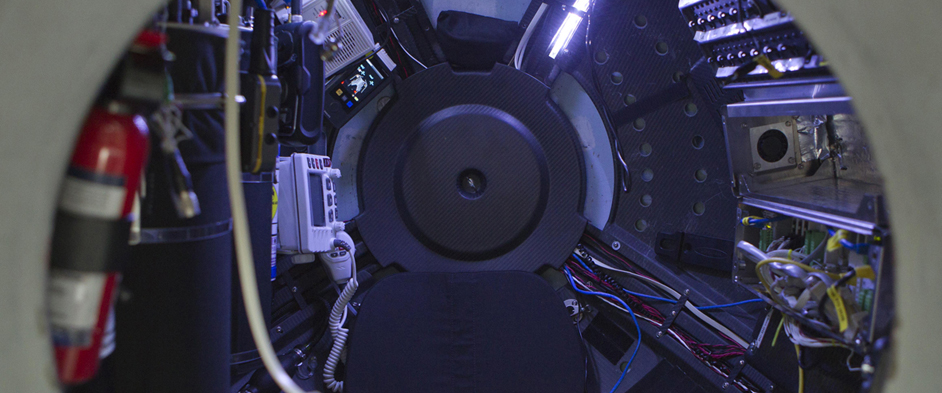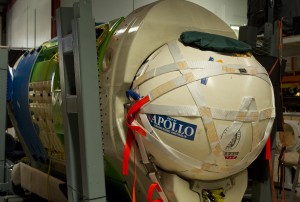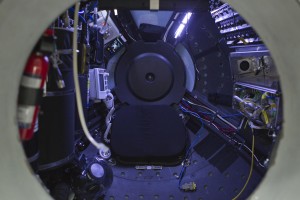PILOT SPHERE

Although the DEEPSEA CHALLENGER is as long as a stretch limo, the pilot’s home will be the cramped pilot sphere. With an internal diameter of 43 inches (109 centimeters) and an interior filled with electronics and life-support equipment, the sphere is so small that while inside the pilot’s legs are tightly bent and he can barely move his arms.
This steel orb is equipped to make sure the pilot gets oxygen, stays warm, and is shielded from the deep-sea pressure.
Engineers made the pilot’s chamber spherical because the shape can be both strong and light. They also made the steel 2.5 inches (6.4 centimeters) thick to withstand the crushing pressure of the deep. If they had made the chamber a cylinder, by comparison, the hull would have needed to have been three times as thick to stand up to the pressure. The hull, complete with its hatch and viewport, was tested twice before the DEEPSEA CHALLENGE expedition in a pressure chamber at Pennsylvania State University to an equivalent full-ocean-depth pressure of 16,500 pounds per square inch (1,138 bars). It passed both tests. Twenty-two strain gauges attached to the sphere gave data that indicated the sphere could withstand up to 140 percent of the test pressure without buckling.

Photograph by Mark Thiessen
During the descent, James Cameron will occupy the pilot sphere. The sphere is held in position with straps. Green cloth covers the sphere.
When designing the sub, James Cameron and Ron Allum kept the sphere’s internal diameter to 43 inches (109 centimeters) because, as the heaviest part of the sub, its weight dramatically impacts the overall size of the vehicle. The heavier the sphere, the more foam would be needed to float the entire structure back to the surface. And the foam itself, capable of withstanding the crushing pressures at full ocean depth, is quite dense. More weight, more foam. More foam … more weight. It adds up quickly and dramatically. To keep the sub small enough to launch and recover from a ship, as opposed to being towed to the site like the Trieste, it was critical to have as small a sphere as possible.
The sphere’s interior is covered with electronics, screens, circuit breakers, and tanks. The pilot’s seat perches above a set of emergency batteries. To his right canisters and tanks absorb carbon dioxide and release oxygen, and to his left the dashboard offers an array of buttons controlling everything from power to communications. Inches from the pilot’s face a screen projects images captured by a Red Epic 5K camera that generates a wide-angle view—better than what the pilot could see with his eyes—from the narrow end of the sphere’s cone-shaped window. A touch screen next to the “virtual viewport” helps him monitor everything from battery power to oxygen levels. The interior also includes food, water, and joysticks connected to the “thrusters,” essentially motors that help the sub move horizontally and vertically.
The interior of the tiny compartment is designed to accommodate the pilot’s exact bodily requirements. Engineers studied Cameron’s and Allum’s breathing rates while they were resting and exercising—increased oxygen intake while exercising mimics intake while stressed—and calibrated the sub’s oxygen feed to meet their physical needs.
The sub is equipped with two compressed oxygen cylinders, which contain enough O2 to keep the pilot breathing for up to 56 hours. Cameron trained for the dive by doing exercises to increase his lung capacity and his body’s oxygen efficiency. He prepared by running and free diving regularly.
“Freediving teaches you to be calm and self-reliant and to ‘pre-visualize’ every dive before you make it, so that your mind is clear and focused during the dive itself,” says Cameron. “It also improves your breath-holding capability, which may come in handy if there is a fire inside the sub’s pilot sphere. An electrical fire would contaminate the air with toxic smoke instantly, turning it unbreathable. The plan is to switch quickly to full face mask attached to a closed-loop rebreather unit. This takes precious seconds, and being able to stay calm while holding one’s breath could mean the difference between life or death. Of course, I’ve been trained by my life-support team in this and other contingency scenarios, and that training also keeps you calm and clear-headed in an emergency.”
But keeping the pilot breathing isn’t just a matter of sending him into the deep with ample oxygen. He’ll also need the carbon dioxide and water vapor he exhales removed from the sphere’s air supply. Scrubbers absorb excess carbon dioxide, while water vapor from his breath and sweat condense on the sphere’s cool steel and trickle to the lowest portion of the sub, where it pools in a sump and can be pumped into a bag. In an emergency, the pilot can drink it using a special straw designed to filter out contaminants.
Periodically, the sub automatically sends telemetry back to the ship with the pressure, temperature, oxygen levels, and other data. The expedition’s dive doctor reviews these figures to make sure the sphere is providing a habitable environment.

Photograph by Mark Thiessen
The interior of the pilot sphere simulator is shown at Acheron Project offices in Sydney, Australia. The sphere, with an interior diameter of 43 inches (109 centimeters), provides life support, communications, and control of the submersible during the descent.
Independent batteries can run the life-support system in an emergency. Everything possible, even the tape used inside the sphere and the pilot’s clothing, is fire-resistant, so if any of the batteries or wiring were to catch fire, the pilot would be able to put it out quickly. To keep warm, the pilot had a change of clothing—when he started, he was sweating, as the sphere’s electronics heated the sphere rapidly. He also had a vacuum-packed, electronically heated suit, along with a sleeping bag and other layers to keep him warm if he found himself up stuck on the bottom for an extended period. At full ocean depth, the temperature approaches freezing.



